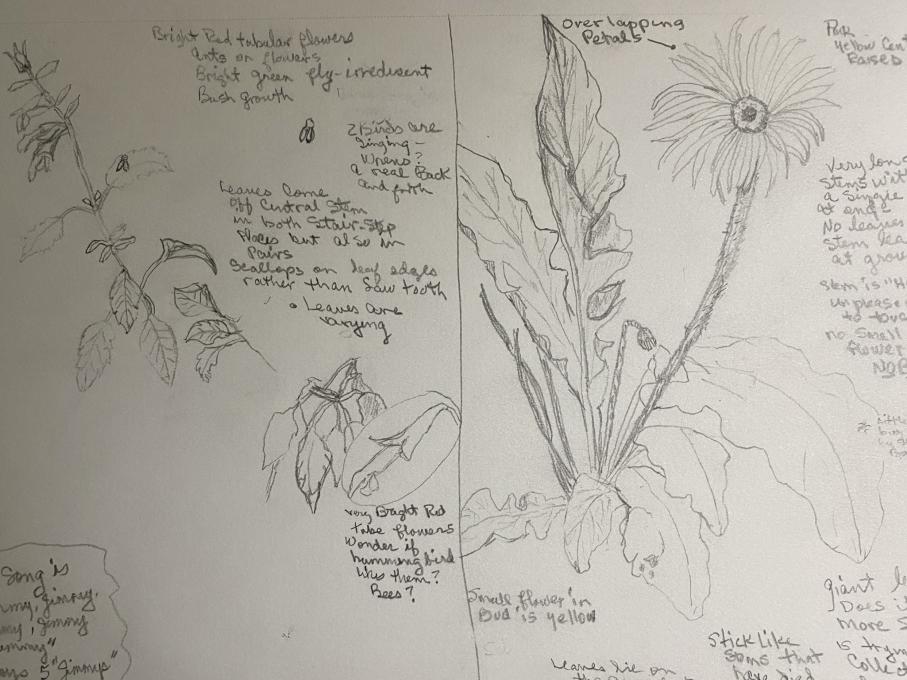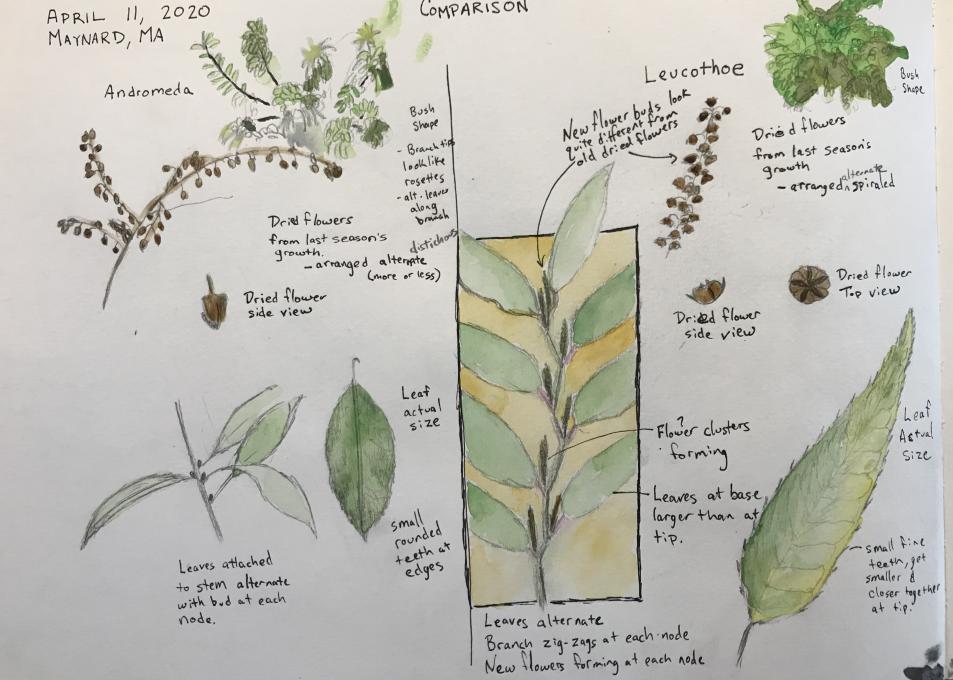The Cornell Lab Bird Academy › Discussion Groups › Nature Journaling and Field Sketching › The Power of Comparison
-
I really like the comparison lesson. It's amazing how toggling back and forth between two leaves reveals things you wouldn't notice were you drawing them individually. I'm still overworking the medium to try and get the colors and values correct, but hope I'll improve over time.

-
Your choice of leaves is a nice departure from the more dramatic flowers, yet they are so pretty and offer a wonderful comparison. City life offers possibilities, too. Bravo.
-
-
Living in NYC I don't feel comfortable taking a bus/train to get to the nearest park so I've been googling images for references. I couldn't get as much detailed as I wanted but I enjoyed the process. I can't wait to be able to do this in the real world.

-
I am enjoying this course and finding that sitting, listening and observing the small things in detail amid the larger surroundings quite absorbing and calming. Sketching does make one take the time to really observe and think further. This has been a wonderful way to observe the arrival of spring and see connections in nature that I have not noticed before. I am so impressed by everyones submissions! I hope to add color to my attempts before long.
 The black flies and ticks are currently limiting my time sitting outside (and the yard work that needs attention)
The black flies and ticks are currently limiting my time sitting outside (and the yard work that needs attention)
-
I love this black and white drawing and the detail, too. I have both in my yard. I am tempted to try these, as well, or perhaps couple the bleeding heart with an azalea nearby.
-
-
 These were definitely two very different flowers. The columbine flower fell apart before I could finish drawing it, but it had very unusual petals (see top of picture for the real petals). Drawing these flowers has made me want to restudy the parts of a plant because each of the recent flowers I have drawn in this journal had me looking up flower parts and I still feel a little unclear about what was what. I would have called the sepals on the columbine petals...I found myself pondering the pollinators who would prefer these two plants - one with a very flat landing pad and one where you would need to approach the flower from underneath. Because the flower fell apart I was better able to discern its separate parts. If you had enough flowers to do this, I can see the advantage of taking a flower apart to better understand its components.
I like to have plenty of room for the image so I sometimes have additional notes on another page.
These were definitely two very different flowers. The columbine flower fell apart before I could finish drawing it, but it had very unusual petals (see top of picture for the real petals). Drawing these flowers has made me want to restudy the parts of a plant because each of the recent flowers I have drawn in this journal had me looking up flower parts and I still feel a little unclear about what was what. I would have called the sepals on the columbine petals...I found myself pondering the pollinators who would prefer these two plants - one with a very flat landing pad and one where you would need to approach the flower from underneath. Because the flower fell apart I was better able to discern its separate parts. If you had enough flowers to do this, I can see the advantage of taking a flower apart to better understand its components.
I like to have plenty of room for the image so I sometimes have additional notes on another page. -
Wow, your colors are so rich and full of life! That Columbine is a beauty . . . unique in elegance and mystery. I never realized how fascinating Columbine is; you have really captured the loveliness of that flower. I also know what you mean about sepals and tepals and petals - so much to learn. Your pages look so effortless, but yet detailed. It seems like you are having fun! Thanks for sharing.
-
These drawings are gorgeous and so detailed. They leap off the page, and it is so artistically arranged. Inspiring.
-
-

-
Your drawings & writing information continues to just leap off the page and grab my attention. Thanks for sharing.
-
I agree with Colleen. I love the drawings themselves...they are just gorgeous. The way you have put the page together is so well done - the drawings, the information, the writing, the titles, and the placement of all of the elements holds the page together beautifully and makes me want to learn all about it.
-
Your drawings are stunning, as though ready for a magazine. The detail and color inspires me to try this, too. I often color in Johanna Basford books. This is far more beautiful; its real.
-
-

-
Enjoyed this exercise! It helps watching the video and seeing how everyone else is doing it. It helps get past the, “oh no, it’s a blank page” in front of me!

-
 1: Yes, I tried a comparison study & learned that I really need to do more of them. It brings out the child-like wonder, awe, & curiosity of learning & exploration that I miss. I did my study on 3 different types of Irises in my front yard & gardens. I noticed that Irises have lots of differences in color, shape, size, quantity, function, & systems. They also share similarities. The “why” questions of color, shape, size, quantity, function & systems all expanded into further study ideas & more questions to ask.
2: To balance my journal pages, I need to add more writing details & get use to adding numerical data to the drawings. I have been focused on the drawings & making them detailed & life-like, and by leaving off the information of who, what, where, when, why, & how that tells the whole story, was the important missing pieces to complete the pages. Everything is equally important.
1: Yes, I tried a comparison study & learned that I really need to do more of them. It brings out the child-like wonder, awe, & curiosity of learning & exploration that I miss. I did my study on 3 different types of Irises in my front yard & gardens. I noticed that Irises have lots of differences in color, shape, size, quantity, function, & systems. They also share similarities. The “why” questions of color, shape, size, quantity, function & systems all expanded into further study ideas & more questions to ask.
2: To balance my journal pages, I need to add more writing details & get use to adding numerical data to the drawings. I have been focused on the drawings & making them detailed & life-like, and by leaving off the information of who, what, where, when, why, & how that tells the whole story, was the important missing pieces to complete the pages. Everything is equally important. -
Hi, Colleen. Your irises are beautiful. You’ve captured the small details and rich colors of each flower. I really like the way you organized your information. It makes your page easy to read and understand. I wish I had irises in my yard!
-
@Leonora Thanks so much for the comment. I am still working on adding more information to my journal pages like you have done so beautifully on yours during this course.
-
-
I decided to compare these two plants in my back yard. It’s an unmanicured bluff overlooking Lake Michigan. Some of the vegetation was intentionally planted by the prior owner, but most is native happenstance. I think these two plants are natural inhabitants of the land. I have no idea what either one is, but am now curious to find out. The comparison study caused me to think about qualities that I might not have noticed if I were just looking at one plant by itself.

-
I have tried a comparison study. Since I have seen the video I have started to notice things differently in the nature. I decided to compare two herbs and I have noticed different colors, texture, and leaves. By observing them during a comparison study I have noticed that parsley has got big leaves with a triad of leaves together while a thyme has got many leaves in a more symmetric shape. It was difficult to draw them, but the comparison observation made me thinking how many times I have not noticed things that are there. I do not like eating parsley, but after the comparison study I have to admit that I like its colors very much. It brings me happiness and light.

-
I've always thought that parsley TASTES happy!
-
-
I'm so far behind on this course I think I'm in front. Yesterday I went out to do my comparison study, our first decent day weather-wise in two weeks. Either freezing to death or drowning in rain! Some Virginia spring! I compared two common weeds, common cinquefoil and what is called Indian mock-strawberry. Both have tiny yellow flowers. Both have palmate leaves. Both are growing abundantly with all the rain. My sit spot is in our "bird garden," a mulched patch with old-growth trees, holly shrubs, about ten feeders of different kinds (viewable from our breakfast nook window), bird bath, and the fattest squirrels who live in condos in the big trees. The feeders attract the usual suspects: cardinals, house finches, downies, red-bellies, nuthatches, tufted titmice, chickadees, mourning doves, "snowbirds" that have just left, blue jays, bluebirds, robins, catbirds (who knew they eat suet?), and northern flickers.

-
Thanks for sharing your Comparison study. I am having the same issue with the rain and the growth of both these weeds that I have just learned the name of. Love the details of your drawings.
-
@Colleen Three months of triple digit heat has gotten me behind, too! Yesterday I took some cuttings and drew them indoors!
-
-
Our state parks reopened this week, so my husband and I headed to Enchanted Rock to hike the Echo Canyon Trail. I’m an official interpretive guide for the park but haven’t been able to lead any hikes since the pandemic. Only a few visitors are allowed at the park, must wear masks and social distance, so it was very peaceful with a lot less visitors than normal. It’s my favorite time of year at Enchanted Rock with all the gorgeous wildflowers blooming. I did an observation of two yellow flowers in bloom, the prickly pear cactus and a brown bitter weed. I loved the experience of detailing what I saw in the journal. I need a bigger journal for sure. I have much more I would have liked to write down if there was space.

-
I did my comparison on a dangerous situation involving an invasive species threatening another species brought to the Americas in the 1800s, the honey bee. A single Asian Giant Hornet can decimate a honey bee hive in about 3 hours. If you see one of these hornet contact your state agriculture department.

-
Hi Nancy, Thank you so much for posting this important page. I admired your notes and your drawings, and now I’ll be able to identify that hornet. Thanks. Ann
-
@Ann Hi, Nancy. Wow, 2 inches long - that really is a giant hornet! AND it decapitates the poor honey bees - yikes. I don’t have any bee boxes, but have family/friends who do; they must be concerned. I’m so glad I read your journal pages, well done and topical. Many thanks.
-
-

-

-
It was quite fun to do a comparison study. Especially once you realise there's so many details you don't take in unless you are actively looking for diferences. As a field biologist I have no problems balancing drawing, writing and numbers and actually wonder how did it take me so long to start sketching the things I was seeing!

-
I wanted to do a comparison of some interesting birds but, with cool outdoor temperatures still (and limited access to parks due to the current COVID-19 lockdown), I used a postcard someone had sent me years ago showing six different owl heads. I chose two that I have personally seen and sketched them below, then looked in my bird guides for information on each one. 1) I learned there are many differences in colour, size, shape, and behaviour between the two species although they have common features, such as no ear tufts and large facial disks to gather light while hunting at night. 2) I think it's possible to combine drawings, written comments, and measurements or other numeriacal data on the journal page as they come to you (or as you find things in research material). This somewhat cluttered look appeals to me as it makes you study the finished page more carefully later when you want to review all the facts and features of the observations.

-
I noticed the bend in the cedar branch and how they are related to the greenery, and how loose the twigs are. I took more time studying the underside of the hemlock needle, and how dense they are. So... more detail seen and investigated. Balancing data, text and drawings will take practice. Need to investigate more before drawings to determine what is needed, them lay out, leaving space for additional discoveries.

-
I found my first comparison study very difficult ... choosing to sketch two orchids was way too ambitious. It was challenging to get proportions right, to indicate texture and shading, and it was especially hard to capture the tiny details, but it was a great exercise in observing closely! I’m hoping the future lessons will help me improve my drawing skills. As for a balance on my journal pages, I’ve followed Jack Laws’ videos for several months, and I have his book on Nature Journaling, so I had started developing a style, but got away from it when I started the course. I think it’s time to return to some of that now, in terms of how I lay out each page, and what I include. I love this course and am learning so much! Thank you, Liz!

-
 I found it to be a useful exercise but once in the middle of it I realized choosing two more contrasting examples would have been better, since the two plants might just have been the same with different color and growth stages. Still useful as a practice tool. Also taught me to better organize comparison criteria: height, color, type of plant, leaf and petal dimensions and characteristics, etc... I went about it a little haphazardly. Great practice, nonetheless. Anything that sharpens the eye and trains you to observe and note, is good!
I found it to be a useful exercise but once in the middle of it I realized choosing two more contrasting examples would have been better, since the two plants might just have been the same with different color and growth stages. Still useful as a practice tool. Also taught me to better organize comparison criteria: height, color, type of plant, leaf and petal dimensions and characteristics, etc... I went about it a little haphazardly. Great practice, nonetheless. Anything that sharpens the eye and trains you to observe and note, is good! -
 I sat outside for a short period on a chilly April day trying to sketch in between online classes I had to teach. I almost resented going back inside. I was in the edge of the woods so the Mayapples are already here and the invasive Garlic Mustard plants. As I walked through the woods I looked down and saw these as a top down viewpoint. Of course the Garlic Mustard is taller than the parasol like Mayapples(no "apple" yet) and has already begun to flower with a 4 petal white flower and has ridged leaves versus the Mayapple with the symmetrical lobed leaves.
I sat outside for a short period on a chilly April day trying to sketch in between online classes I had to teach. I almost resented going back inside. I was in the edge of the woods so the Mayapples are already here and the invasive Garlic Mustard plants. As I walked through the woods I looked down and saw these as a top down viewpoint. Of course the Garlic Mustard is taller than the parasol like Mayapples(no "apple" yet) and has already begun to flower with a 4 petal white flower and has ridged leaves versus the Mayapple with the symmetrical lobed leaves. -
This was my first effort at field journal comparison journal. I had fun sitting on a stool in a small garden in my backyard during the “stay at home” order. I found so many interesting things to follow up on like the iridescent blue green fly that kept me company. I found out later that he is called a “long legged” fly and he is a decomposed. So fit right in with our lesson. I compared a gerbra daisy with a salvia. Here is my journal page, which really spilled over to another page because it was so interesting, I had to follow up on the internet with some questions.

-
I compared andromeda and leucothoe, both planted in my yard. I chose these because of some superficial similarities: general leaf shape, presence of dried flowers from last season, new spring flowers forming, overall shape and size of the shrub. By looking more closely, I could see that the form and branching was quite different. The arrangement of leaves (alternate on both) showed some observable differences, too. The andromeda appears from a distance has a rosette of leaves at the end of each branch. The leucothoe has alternating leaves at each node, and the stem itself zig-zags at each node, whereas the andromeda's stem remains straight at the nodes.

-
It's spring, so there's new growth in our yard. I compared the new growth of an evergreen and a perennial. Enlightening! When writing and recording as descriptive, the location/placement of info. seems self-evident. Artful? A goal for sure, as is figuring out how to insert image.< ;

-
I did a comparison of two flowering plants that are forming mattes in my currently fallow garden area. It really did help to focus attention on various details doing the comparison. The two form very dense mattes, and appears there is some type of competition going on between them. Putting two items on the same page is a great technique!

Read More:
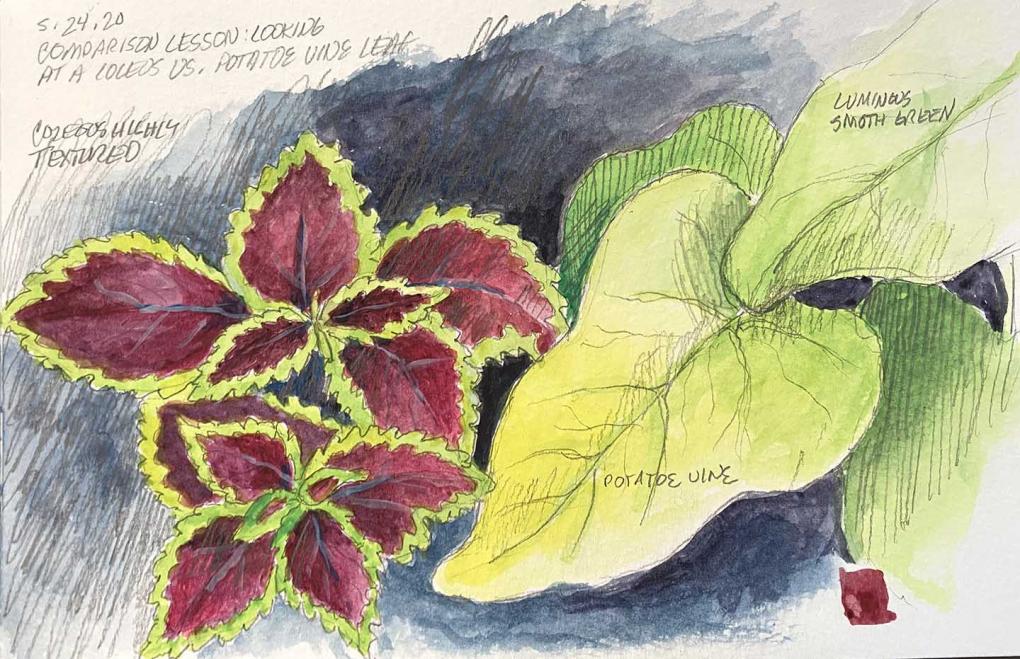
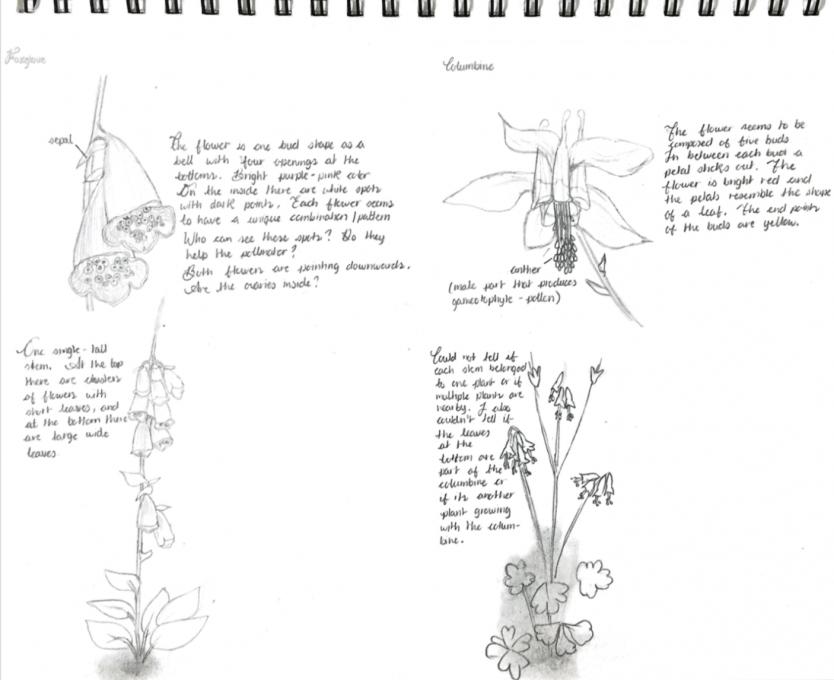
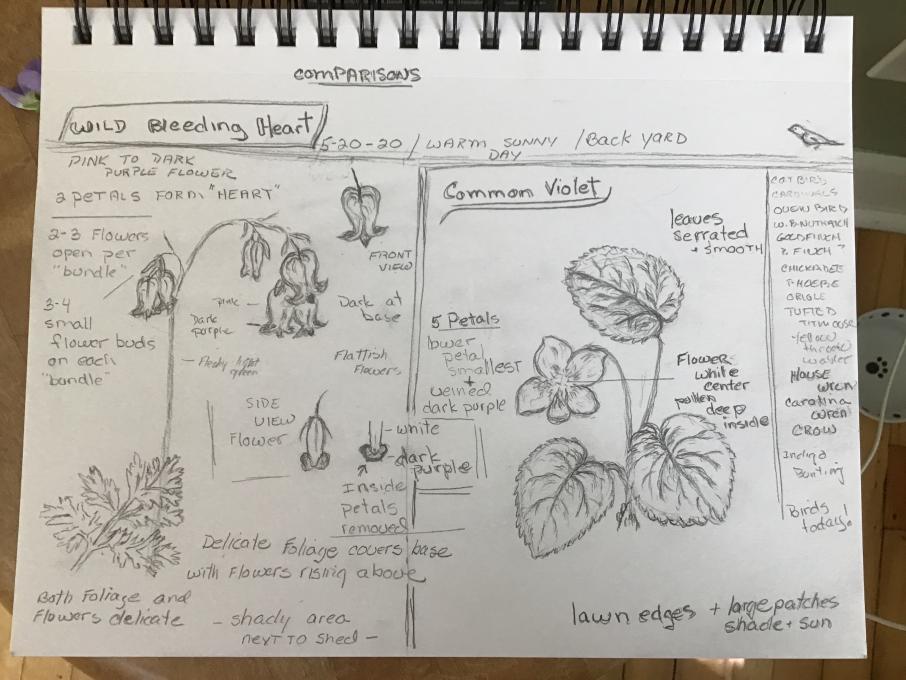 The black flies and ticks are currently limiting my time sitting outside (and the yard work that needs attention)
The black flies and ticks are currently limiting my time sitting outside (and the yard work that needs attention)
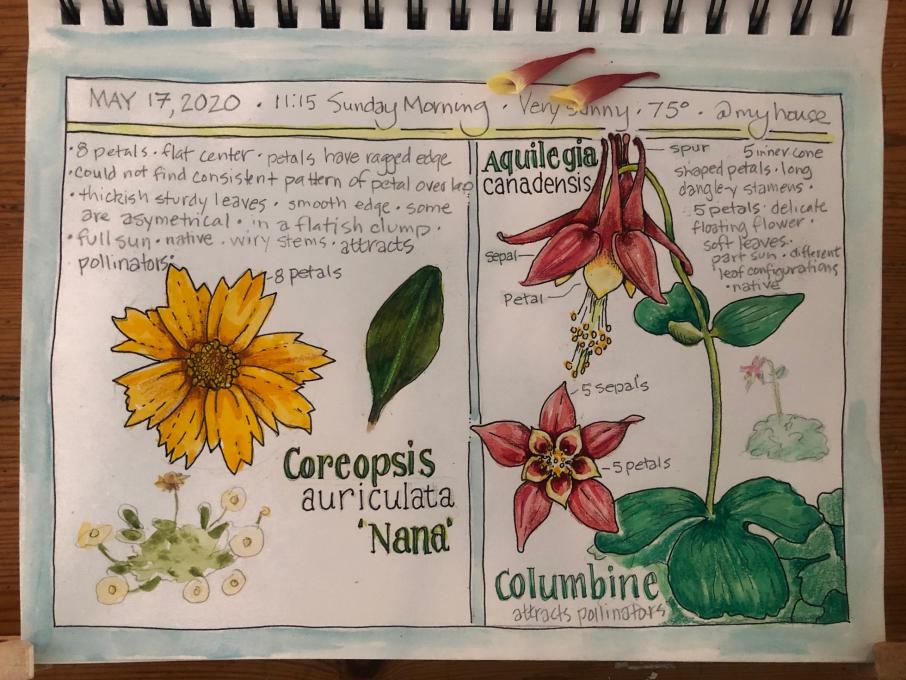 These were definitely two very different flowers. The columbine flower fell apart before I could finish drawing it, but it had very unusual petals (see top of picture for the real petals). Drawing these flowers has made me want to restudy the parts of a plant because each of the recent flowers I have drawn in this journal had me looking up flower parts and I still feel a little unclear about what was what. I would have called the sepals on the columbine petals...I found myself pondering the pollinators who would prefer these two plants - one with a very flat landing pad and one where you would need to approach the flower from underneath. Because the flower fell apart I was better able to discern its separate parts. If you had enough flowers to do this, I can see the advantage of taking a flower apart to better understand its components.
I like to have plenty of room for the image so I sometimes have additional notes on another page.
These were definitely two very different flowers. The columbine flower fell apart before I could finish drawing it, but it had very unusual petals (see top of picture for the real petals). Drawing these flowers has made me want to restudy the parts of a plant because each of the recent flowers I have drawn in this journal had me looking up flower parts and I still feel a little unclear about what was what. I would have called the sepals on the columbine petals...I found myself pondering the pollinators who would prefer these two plants - one with a very flat landing pad and one where you would need to approach the flower from underneath. Because the flower fell apart I was better able to discern its separate parts. If you had enough flowers to do this, I can see the advantage of taking a flower apart to better understand its components.
I like to have plenty of room for the image so I sometimes have additional notes on another page. 
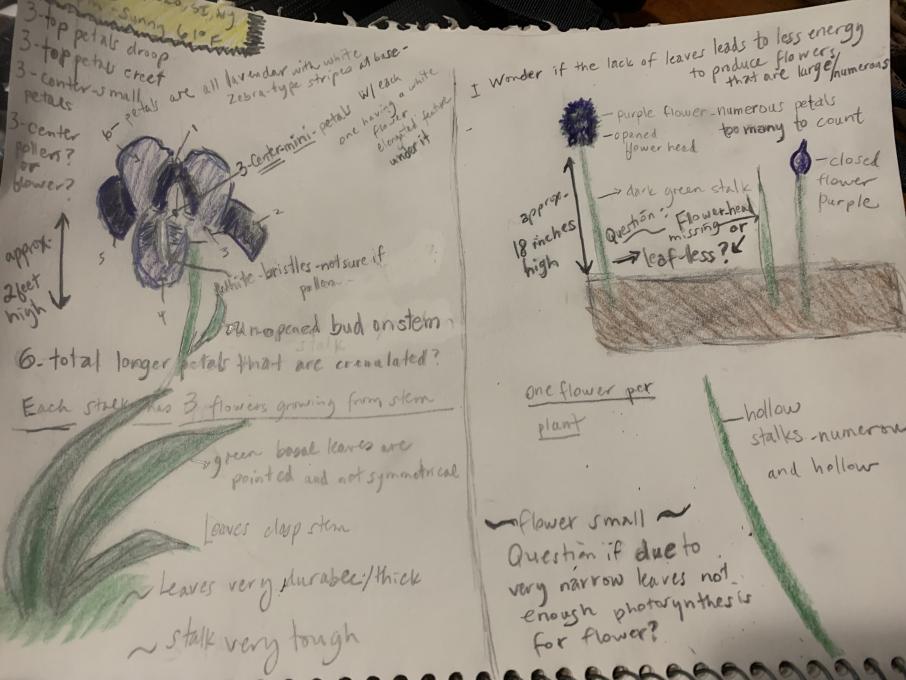

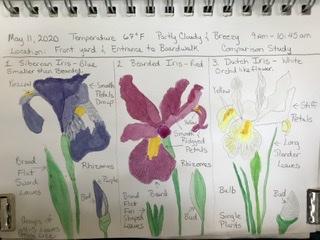 1: Yes, I tried a comparison study & learned that I really need to do more of them. It brings out the child-like wonder, awe, & curiosity of learning & exploration that I miss. I did my study on 3 different types of Irises in my front yard & gardens. I noticed that Irises have lots of differences in color, shape, size, quantity, function, & systems. They also share similarities. The “why” questions of color, shape, size, quantity, function & systems all expanded into further study ideas & more questions to ask.
2: To balance my journal pages, I need to add more writing details & get use to adding numerical data to the drawings. I have been focused on the drawings & making them detailed & life-like, and by leaving off the information of who, what, where, when, why, & how that tells the whole story, was the important missing pieces to complete the pages. Everything is equally important.
1: Yes, I tried a comparison study & learned that I really need to do more of them. It brings out the child-like wonder, awe, & curiosity of learning & exploration that I miss. I did my study on 3 different types of Irises in my front yard & gardens. I noticed that Irises have lots of differences in color, shape, size, quantity, function, & systems. They also share similarities. The “why” questions of color, shape, size, quantity, function & systems all expanded into further study ideas & more questions to ask.
2: To balance my journal pages, I need to add more writing details & get use to adding numerical data to the drawings. I have been focused on the drawings & making them detailed & life-like, and by leaving off the information of who, what, where, when, why, & how that tells the whole story, was the important missing pieces to complete the pages. Everything is equally important. 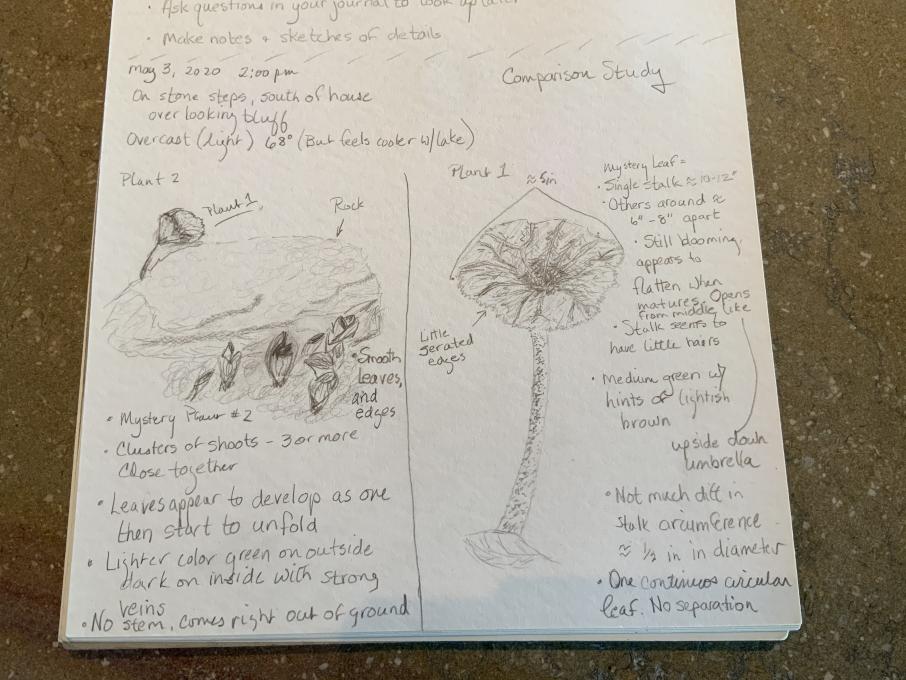
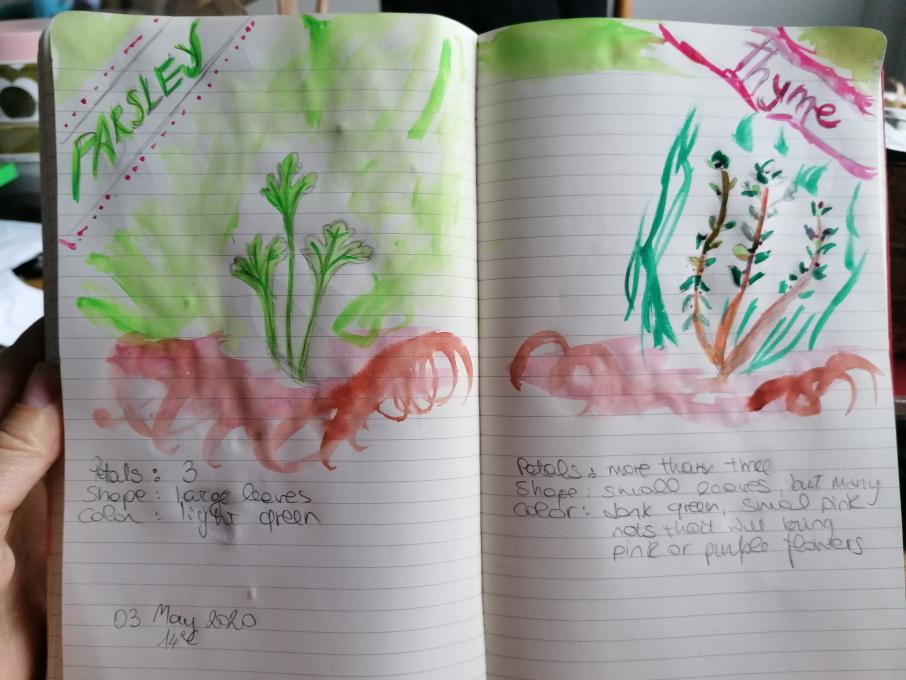


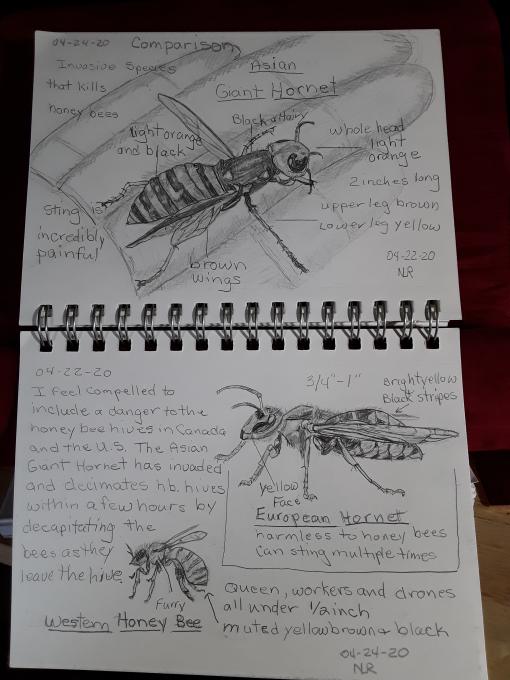
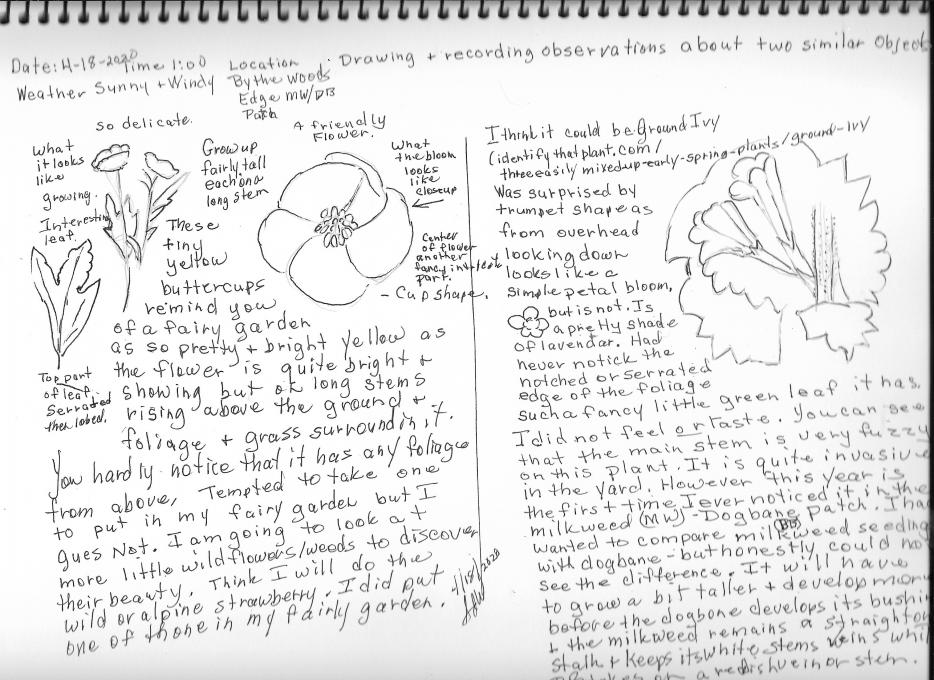
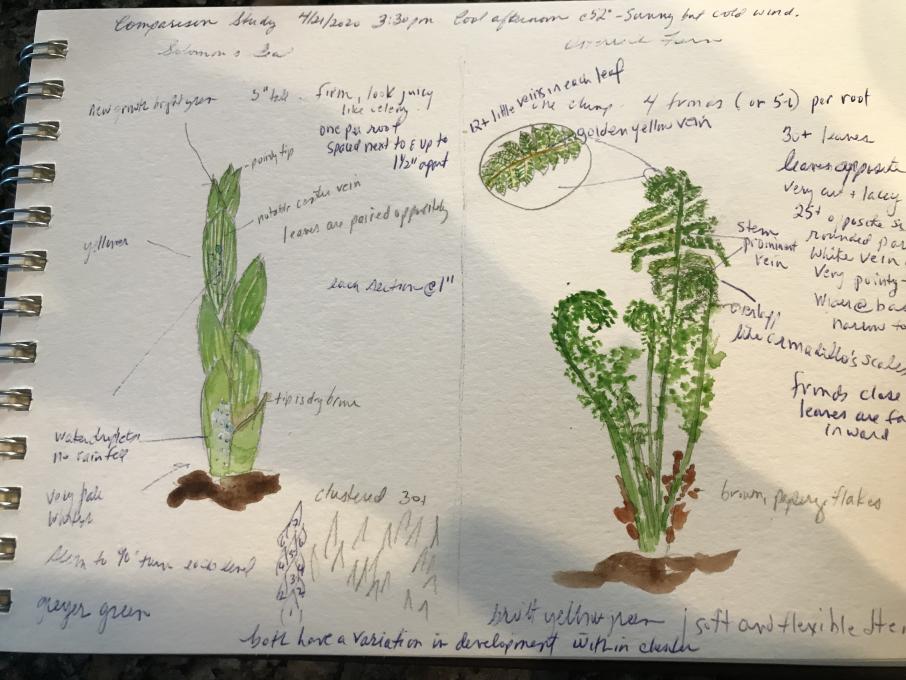
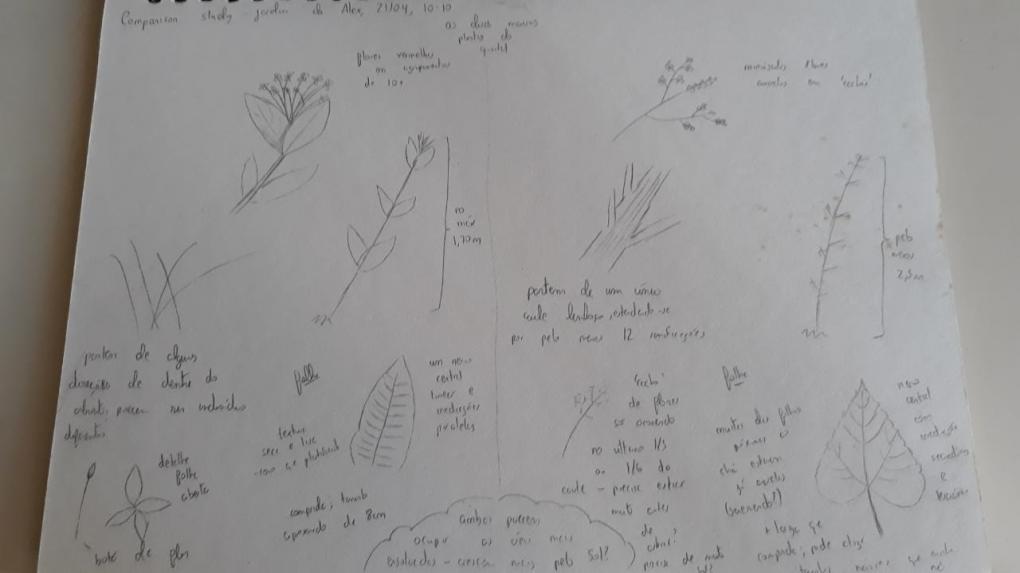
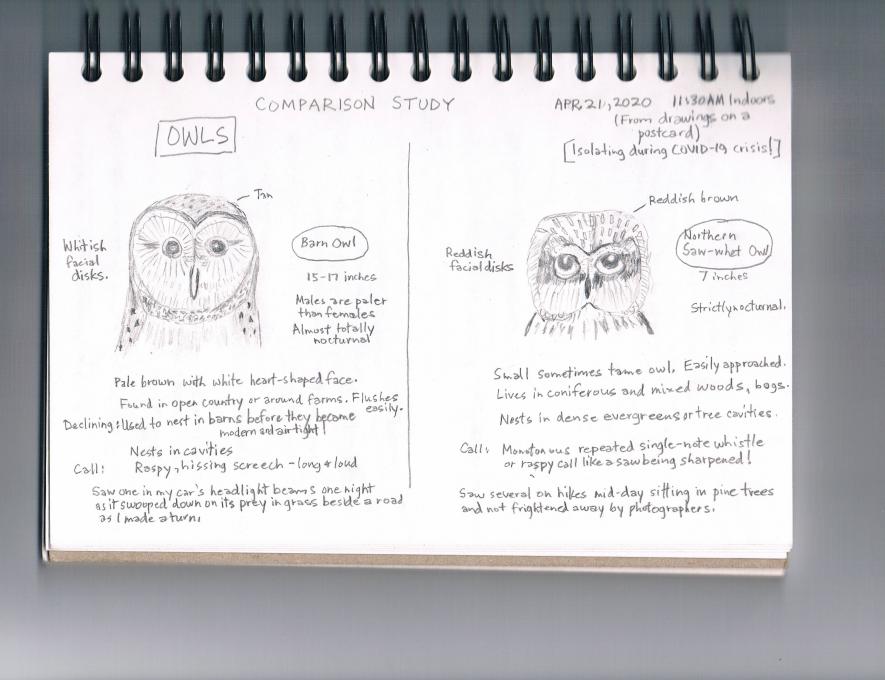
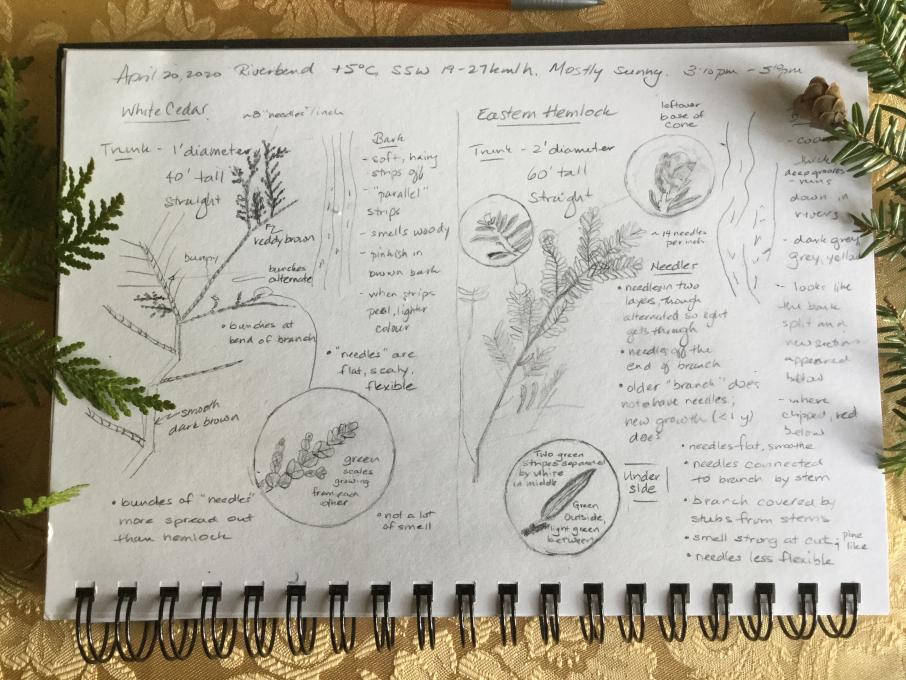

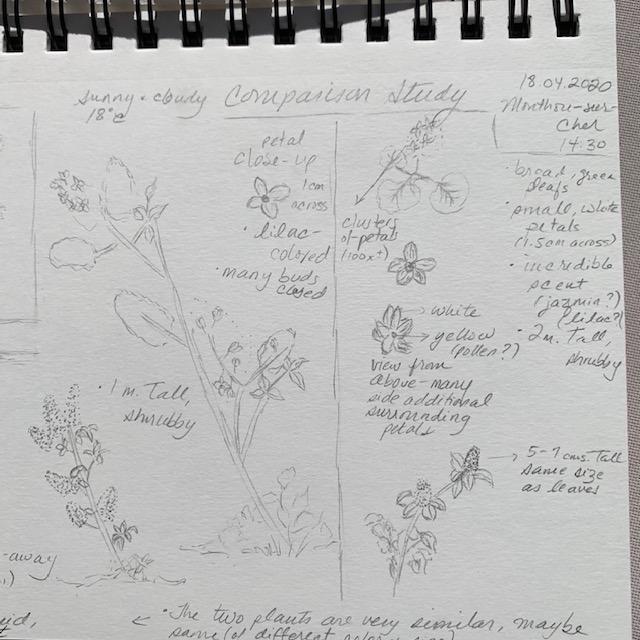 I found it to be a useful exercise but once in the middle of it I realized choosing two more contrasting examples would have been better, since the two plants might just have been the same with different color and growth stages. Still useful as a practice tool. Also taught me to better organize comparison criteria: height, color, type of plant, leaf and petal dimensions and characteristics, etc... I went about it a little haphazardly. Great practice, nonetheless. Anything that sharpens the eye and trains you to observe and note, is good!
I found it to be a useful exercise but once in the middle of it I realized choosing two more contrasting examples would have been better, since the two plants might just have been the same with different color and growth stages. Still useful as a practice tool. Also taught me to better organize comparison criteria: height, color, type of plant, leaf and petal dimensions and characteristics, etc... I went about it a little haphazardly. Great practice, nonetheless. Anything that sharpens the eye and trains you to observe and note, is good!  I sat outside for a short period on a chilly April day trying to sketch in between online classes I had to teach. I almost resented going back inside. I was in the edge of the woods so the Mayapples are already here and the invasive Garlic Mustard plants. As I walked through the woods I looked down and saw these as a top down viewpoint. Of course the Garlic Mustard is taller than the parasol like Mayapples(no "apple" yet) and has already begun to flower with a 4 petal white flower and has ridged leaves versus the Mayapple with the symmetrical lobed leaves.
I sat outside for a short period on a chilly April day trying to sketch in between online classes I had to teach. I almost resented going back inside. I was in the edge of the woods so the Mayapples are already here and the invasive Garlic Mustard plants. As I walked through the woods I looked down and saw these as a top down viewpoint. Of course the Garlic Mustard is taller than the parasol like Mayapples(no "apple" yet) and has already begun to flower with a 4 petal white flower and has ridged leaves versus the Mayapple with the symmetrical lobed leaves. 